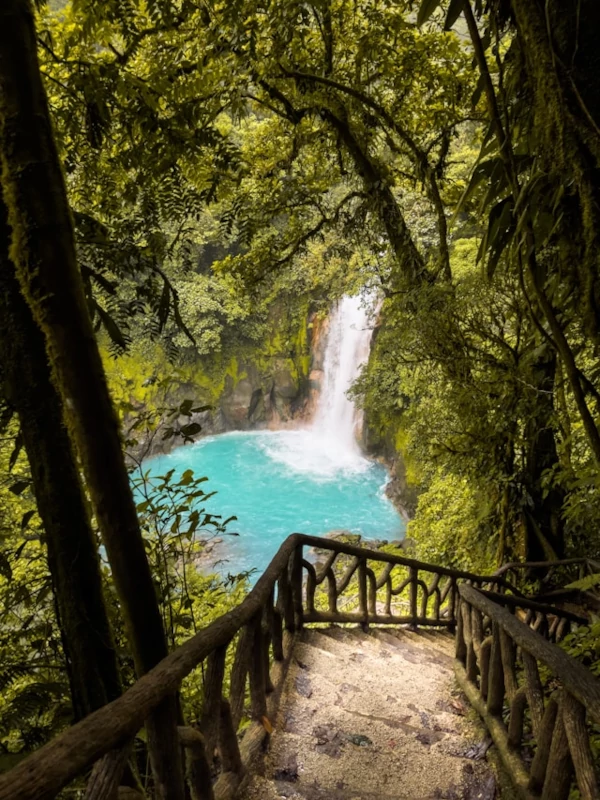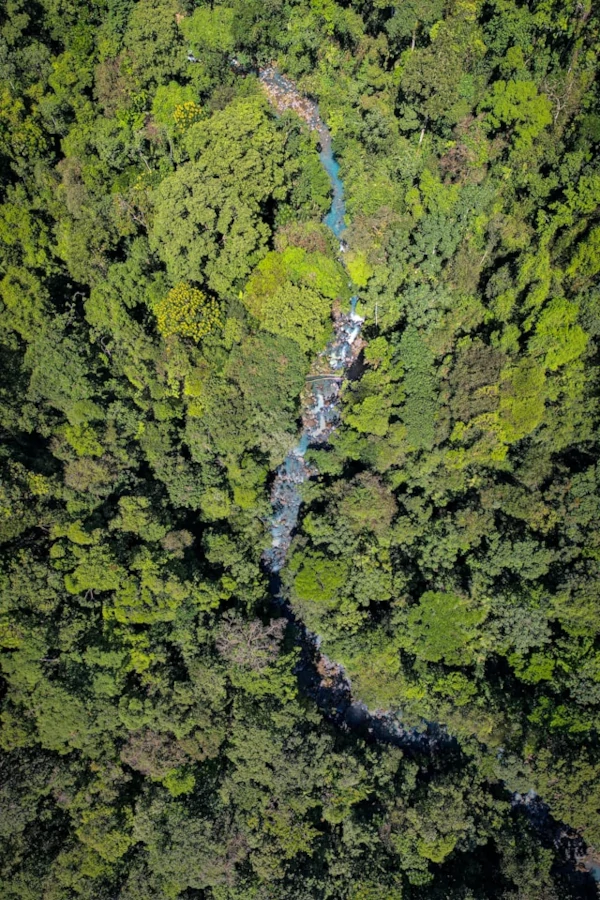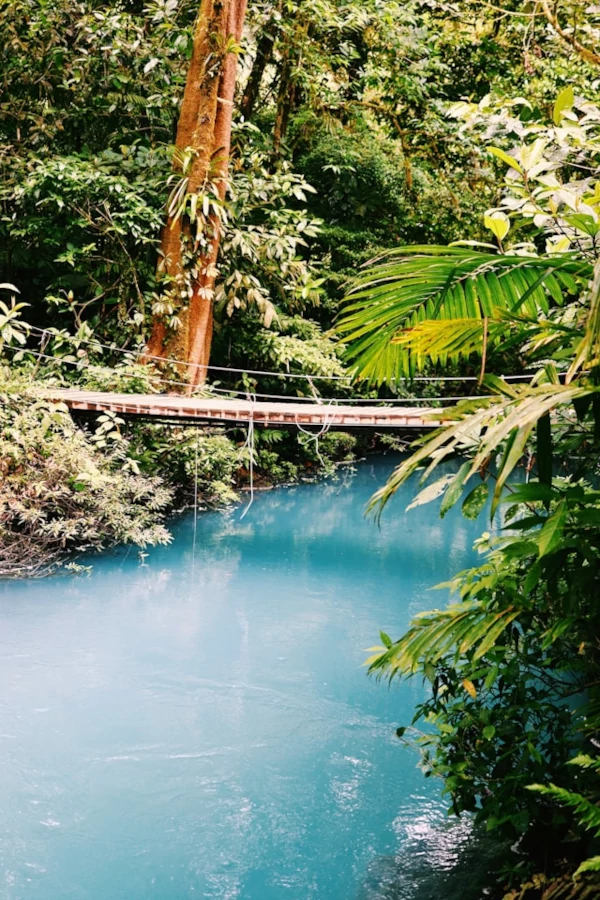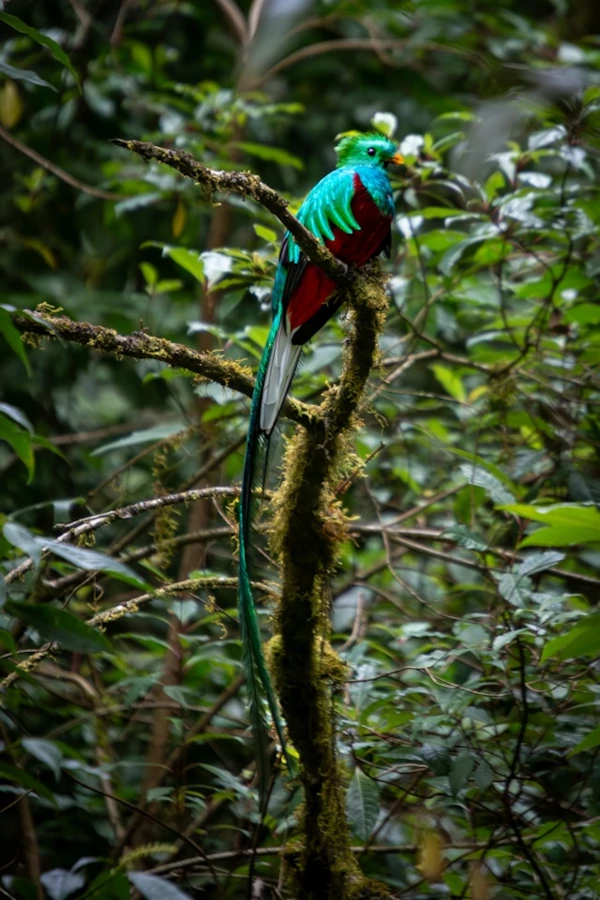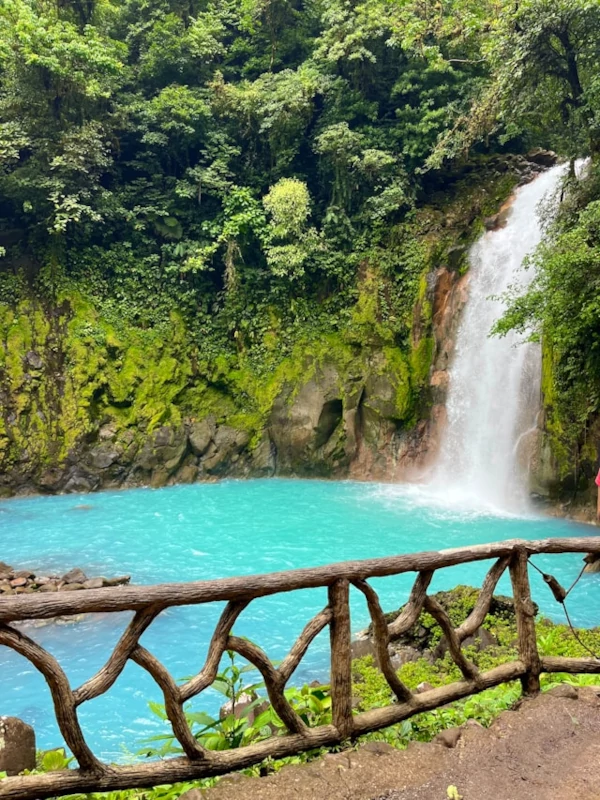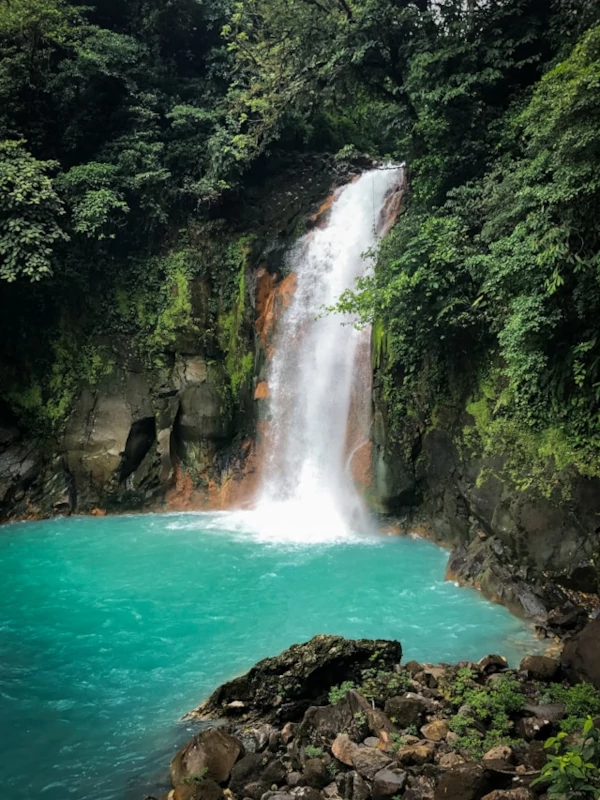The park is renowned for the breathtaking Rio Celeste, a turquoise river formed by volcanic minerals, and its stunning Rio Celeste Waterfall. Visitors can hike through lush rainforests, discover bubbling hot springs, and spot wildlife like sloths, toucans, and tapirs. With its unique blend of natural beauty and biodiversity, Tenorio Volcano National Park is a true gem of Costa Rica.
Tenorio Volcano National Park: Explore Rio Celeste and Costa Rica’s Natural Wonders
Why Visit Tenorio Volcano National Park?
Home to the Stunning Rio Celeste
The centerpiece of Tenorio Volcano National Park is undoubtedly the Rio Celeste, a turquoise river so vibrant it looks like something out of a dream. The river’s magical color comes from a natural chemical reaction between volcanic minerals, creating one of Costa Rica’s most iconic sights. The Rio Celeste Waterfall, where the turquoise water cascades into a serene pool, is a must-see and one of the most photographed spots in the country.
A Haven for Nature Lovers and Hikers
Tenorio Volcano National Park offers an incredible escape into nature, with trails that lead through lush rainforests, past bubbling hot springs, fumaroles, and the striking Teñideros, where two rivers meet and create the magical blue color of Rio Celeste. The park’s trails vary in difficulty, making it accessible for both casual hikers and more adventurous explorers.
A Blend of Volcanoes and Rainforests
The park is named after the Tenorio Volcano, a dormant volcano that adds to the park’s dramatic landscape. While the volcano itself isn’t currently active, its geothermal activity is evident in the park’s hot springs and bubbling mud pools. Surrounding the volcanic features is a dense rainforest, creating a unique environment filled with biodiversity and natural beauty.
An Off-the-Beaten-Path Adventure
Compared to some of Costa Rica’s more famous national parks, Tenorio Volcano National Park offers a more tranquil and less crowded experience. It’s perfect for travelers seeking an authentic connection with nature, away from the hustle and bustle of tourist hotspots. Whether you’re admiring the beauty of the Rio Celeste or soaking in the sounds of the rainforest, the park offers a peaceful retreat.
Visiting Tenorio Volcano National Park is more than just a hike—it’s a chance to witness one of Costa Rica’s most unique natural wonders while connecting with the country’s vibrant ecosystems.
Unique Features and Wildlife of Tenorio Volcano National Park
Rio Celeste: A Natural Marvel
The Rio Celeste is the crown jewel of Tenorio Volcano National Park and one of the most extraordinary natural wonders in Costa Rica. This turquoise river, renowned for its vibrant color, gets its hue from a unique chemical reaction between volcanic minerals at a spot called Los Teñideros, where two rivers converge. Visitors can follow a well-maintained trail that leads to the Rio Celeste Waterfall, where the river dramatically cascades into a serene, blue pool surrounded by lush rainforest. It’s an absolutely breathtaking sight and a highlight of any visit.
Tenorio Volcano: The Park’s Namesake
The park is named after the Tenorio Volcano, a dormant volcano that looms over the area and contributes to the park’s geothermal activity. While the volcano itself is not accessible to hikers, its presence is felt throughout the park in the form of bubbling hot springs, steaming fumaroles, and mud pots. These volcanic features, combined with the lush green surroundings, create a landscape that feels both serene and otherworldly.
Hidden Gems: Hot Springs and Geothermal Activity
As you explore the park’s trails, you’ll come across natural hot springs and bubbling mud pools heated by the volcano’s underground activity. These geothermal features not only showcase the volcanic power that shaped the park but also offer a relaxing and rejuvenating experience for visitors.
Diverse Ecosystems and Scenic Trails
Tenorio Volcano National Park is home to a variety of ecosystems, including cloud forests, rainforests, and volcanic terrain. The park’s trails wind through these diverse landscapes, offering scenic viewpoints, peaceful streams, and dense vegetation filled with wildlife. The combination of unique ecosystems makes every step along the trails an adventure.
Mammals: Sloths, Tapirs, and More
The park’s rainforests are a sanctuary for many of Costa Rica’s iconic mammals. You may spot two-toed or three-toed sloths lounging high in the trees or encounter white-faced capuchin monkeys swinging through the canopy. The elusive Baird’s tapir, the largest land mammal in Central America, also calls this park home, though sightings are rare and exciting. Coatis, known for their curious nature, are frequently seen along the trails.
Birds: A Paradise for Birdwatchers
For bird enthusiasts, Tenorio Volcano National Park is a treasure trove of avian diversity. Over 300 species of birds inhabit the area, including the vibrant toucan, the elusive motmot, and the majestic king vulture. If you’re lucky, you might even spot the resplendent quetzal, one of Costa Rica’s most sought-after birds. The park’s cloud forests provide an ideal habitat for these species, making it a dream destination for birdwatchers.
Reptiles, Amphibians, and Insects
The park is alive with smaller creatures that are just as fascinating. Keep an eye out for poison dart frogs, their bright colors standing out against the green forest floor. Green iguanas and anoles can be seen basking on rocks or tree trunks, while the park’s streams and ponds are home to freshwater turtles. The lush rainforest is also buzzing with insects like blue morpho butterflies, adding intense flashes of color to the trails.
Unique Flora: Orchids, Bromeliads, and More
The park’s plant life is just as remarkable as its wildlife. Tenorio Volcano National Park is home to towering trees, delicate orchids, and bromeliads that cling to branches, adding bursts of color to the green canopy. The park’s diverse flora supports the entire ecosystem, creating a complex and lush environment that’s as captivating as its animal inhabitants.
Visiting Tenorio Volcano National Park means immersing yourself in one of Costa Rica’s most biodiverse landscapes. From the turquoise beauty of Rio Celeste to the incredible array of wildlife and plants, this park offers a truly unforgettable experience for nature lovers and adventurers alike.
Activities in Tenorio Volcano National Park
Hiking to the Rio Celeste Waterfall
One of the most popular activities in Tenorio Volcano National Park is hiking to the breathtaking Rio Celeste Waterfall. This trail takes you through lush rainforest before rewarding you with views of the vibrant turquoise waterfall cascading into a serene pool below. The hike is moderately challenging, with steps leading down to the waterfall, but the view is well worth the effort. The trail also offers excellent opportunities for spotting wildlife like monkeys and birds along the way.
Exploring the Trails and Los Teñideros
The park’s main hiking trail is approximately 7 kilometers (round trip) and leads you to various points of interest, including Los Teñideros, where two clear rivers meet and create the famous turquoise color of the Rio Celeste. Along the way, you’ll encounter bubbling hot springs, fumaroles, and dense rainforest. The trails are well-maintained, making it an enjoyable experience for both beginner and experienced hikers.
Birdwatching and Wildlife Spotting
Tenorio Volcano National Park is a paradise for wildlife enthusiasts. As you hike, listen for the calls of the resplendent quetzal, toucan, or bellbird. Look up to spot sloths lounging in the canopy or watch for the playful antics of white-faced capuchin monkeys. For those interested in amphibians, the park is home to colorful poison dart frogs and a variety of reptiles.
For birdwatchers, we recommend bringing binoculars and visiting early in the morning for the best sightings.
Discovering Hot Springs and Fumaroles
The geothermal activity of the Tenorio Volcano is evident throughout the park. Along the trails, you’ll find natural hot springs, bubbling mud pots, and steaming fumaroles. While the hot springs within the park are not open for bathing, their presence adds to the unique landscape and makes the hike even more fascinating. Nearby eco-lodges outside the park offer hot spring pools for relaxation after a day of hiking.
Photography and Nature Walks
For photographers and nature lovers, Tenorio Volcano National Park offers endless opportunities to capture its beauty. The turquoise river, the vibrant rainforest, and the stunning waterfall make for picture-perfect moments at every turn. Guided nature walks are available for those who want to learn more about the park’s unique ecosystems and discover its hidden gems.
Nearby Adventures
Many visitors to Tenorio Volcano National Park combine their trip with nearby attractions, such as:
- Tubing on Rio Celeste: Enjoy a thrilling ride down sections of the river just outside the park.
- Volcano Viewpoints: Head to nearby vantage points to get panoramic views of the Tenorio Volcano and surrounding landscapes.
Whether you’re hiking to the Rio Celeste Waterfall, spotting exotic wildlife, or soaking in the beauty of the rainforest, Tenorio Volcano National Park offers activities for every nature lover.
Visitor tips
Best Time to Visit
The best time to visit Tenorio Volcano National Park is during the dry season, which runs from December to April. This period offers better trail conditions and clearer skies, ideal for enjoying the turquoise waters of Rio Celeste. However, the green season (May to November) has its own charm, as the rainforest becomes lush and vibrant, but be prepared for rain and muddier trails. If you visit during the rainy season, plan to hike early in the day, as afternoon showers are common.
How to Get There
Tenorio Volcano National Park is located in northern Costa Rica, near the town of Bijagua. Here’s how to reach it:
- By Car: From San José, it’s about a 3.5-hour drive. The park is well-signposted, and the main entrance is accessible via a gravel road. A 4x4 vehicle is recommended, especially during the rainy season.
- By Public Transport: Take a bus from San José to Upala or Cañas, then connect to Bijagua. From Bijagua, you’ll need a taxi to reach the park entrance.
- By Tour: Many tour operators offer day trips from popular destinations like La Fortuna or Liberia, which include transportation and guides.
What to Pack for Your Visit
Packing wisely will help you make the most of your time in the park. Here are the essentials:
- Sturdy hiking shoes or boots: Trails can be muddy, especially during the rainy season.
- Light rain jacket or poncho: Even in the dry season, sudden showers are possible.
- Reusable water bottle: Stay hydrated while reducing plastic waste.
- Sunscreen and insect repellent: Protect yourself from the tropical sun and pesky bugs.
- Binoculars and camera: Perfect for spotting wildlife and capturing the beauty of Rio Celeste.
- Snacks: There are no food vendors inside the park, so pack light snacks to keep your energy up.
Park Entrance and Hours
The park is open daily from 8:00 AM to 4:00 PM, with the last entry allowed at 2:00 PM. The entrance fee is approximately $12 for international visitors and ₡1,000 for Costa Rican residents. It’s best to arrive early to avoid crowds and enjoy the cooler morning temperatures.
Guided vs. Self-Guided Visits
While the trails are well-marked and can be explored independently, hiring a certified guide can greatly enhance your experience. Guides can point out hidden wildlife, explain the volcanic phenomena, and share fascinating facts about the park’s ecosystems.
Safety Tips
- Stay on designated trails: Venturing off the path can be dangerous and harmful to the environment.
- Don’t swim in Rio Celeste: Although the water is beautiful, its high mineral content can irritate the skin.
- Check weather updates: Rain can make trails slippery, so plan your hike accordingly.
Supporting Conservation Efforts
As a protected area, Tenorio Volcano National Park relies on visitors to help preserve its natural beauty. Here’s how you can contribute:
- Avoid littering and take all your trash with you.
- Respect the wildlife by keeping a safe distance and not feeding animals.
- Stay on marked trails to protect delicate plant life.
By following these tips, you’ll ensure a safe, enjoyable, and memorable visit to Tenorio Volcano National Park. Whether you’re hiking to Rio Celeste or exploring the diverse ecosystems, the park promises an unforgettable adventure.





